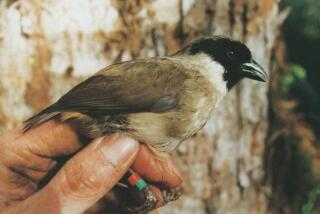22% of Tropic Orchids Are Now Extinct, Study Says
- Share via
BLACKSBURG, Va. — Four percent of Latin America’s tropical plants and 22% of the world’s tropical orchids have become extinct, and their disappearance is occurring faster than scientists had predicted, a UC Irvine study has concluded.
“We’re ahead of schedule,” said one of the study’s authors, Harold Koopowitz, a conservation biologist and expert in tropical plants, particularly orchids.
Koopowitz and his colleague, graduate student Alan Thornhill, found that 2,715 of an estimated 65,000 Latin American tropical plants have become extinct, and species continue to die out at the rate of 84 to 168 a year.
He said his research, presented at a recent meeting of the Society for Conservation Biology, is one of the first efforts to make a precise estimate of the rate at which species are being lost. The rate is higher than many researchers had expected, he said.
Thomas Lovejoy of the Smithsonian Institution, an authority on tropical forests, said that Koopowitz’s study “makes sense--sad sense.”
Lovejoy, who was a member of the U.S. delegation at the Earth Summit in Rio de Janeiro, said Koopowitz’s findings might underestimate the rate of loss because the exact number of species in the tropics isn’t known.
Koopowitz’s findings come from a computer model he and Thornhill developed that uses detailed data on the distribution of plant species.
About 15% of Latin America’s tropical forests have been cut, Koopowitz said. By combining that with the plant distribution data, he calculated that 4% of the tropical plant species have disappeared.
Koopowitz also used the computer model to determine rates of extinction among the 25,000 species of tropical orchids. He calculated that 5,477, or 22%, of the world’s tropical orchids have become extinct.
More to Read
Sign up for Essential California
The most important California stories and recommendations in your inbox every morning.
You may occasionally receive promotional content from the Los Angeles Times.










